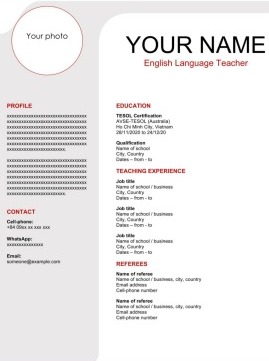How to Create a Brilliant CV for Teaching English in Vietnam

Suppose you’re hunting for hacks to help create a brilliant Curriculum Vitae (CV or Résumé) for teaching English in Vietnam. In that case, you’ve come to the right place. While this post has a ‘Vietnam angle’ because I live and work in Ho Chi Minh City, the hacks equally apply to other Teaching English as a Second Language (TESOL) destinations worldwide. Let’s get stuck into it.
From my experience as someone who employs English as a second language (ESL) teachers, a single job vacancy can attract 50+ CVs. Anecdotally, large English language schools in Vietnam receive 100+ random CVs a day from folks looking to secure a teaching job. Numbers like those tell us that: 1. your CV needs to stand out in the crowd, and 2. you need a quality CV that’s ‘ready to go’ before you arrive in Vietnam. What exactly is a CV? In ‘lay’ terms, a CV is a written summary of a person’s background, qualifications, and employment history.
The significance of a quality CV responsive to local expectations must be considered. Your CV is the most critical document you’ll submit to a potential employer. Given the number of CVs and related documents that a single employer processes daily (note my comments above), your CV needs to be ‘noticed’ by the decision-maker in less than two seconds. It must include relevant information in a compartmentalised format – and an engaging (professional) photo. Your CV must be no more than one page and easy to scan visually. Your CV for teaching English in Vietnam must be formatted as local employers expect. Check out the sample CV below.
Let’s look at the sample CV in more detail, starting from the left-hand side of the document.
Photo: Your photo must show you’re a professional person with an engaging disposition who’s well-suited to teaching English in Vietnam. It needs to strike a balance between formal and informal. If you’re not photogenic, here are some tips: choose the background carefully, don’t look at the camera, find your good side, place the camera slightly above eye level, avoid a double chin, make sure your eyes are wide open – and get the lighting right. You’ll find plenty more photo tips on the internet. You might even have a family member or a friend who’s pretty handy with a camera.
Profile: This CV section allows you to sell yourself to the employer in two short paragraphs, totalling no more than 100 words. Most employers are intelligent people. They can see through ‘fluff’. Be honest. Choose words that show you’re engaging and qualified for a decent job teaching English in Vietnam. The employer needs to know that you’re attuned to the importance of lesson planning, inclusivity, delivering a highly interactive and fun classroom environment, and the like.
Contact: Include a local phone number on your CV. Suppose a Vietnamese employer can choose between calling candidate A with a local phone number or candidate B with an international number. Almost certainly, the employer will opt for the local number. Make sure your email address presents you in a professional manner. If your email address is something akin to ‘hotboy@yahoo.com’, ‘allnightlong@gmail.com,’ or similar, changing it would be a good idea.
Your name: Some folks have long names that occupy much space. If you’re in this camp, I’d suggest shortening your name so the text sits nicely on the CV. Let’s imagine your name is Trixibelle Maryanne Esplanardo. It’s lovely, but it’s wordy. How about going with something like Trixibelle Esplanardo? The letters will fit comfortably in the available space.
Education: Your government-regulated TESOL or TEFL certification (either is fine), like what’s offered by AVSE-TESOL in Ho Chi Minh City, should be listed first. Why? It’s essentially your ‘licence’ to teach. Your highest degree should come next – Doctorate, Masters or Bachelors. Remember that a degree (any discipline) is mandatory for a teaching-related Work Permit in Vietnam. Here’s an example of how your qualifications should look on your CV:
TESOL Certification (Australian Government accredited)
AVSE-TESOL
Ho Chi Minh City, Vietnam
02/02/24 – 02/03/24 (in-class)
Bachelor of Arts (Legal Studies)
LaTrobe University
Melbourne, Australia
03/03/2001 – 10/11/2005
Teaching Experience: This heading presents challenges for people completely new to teaching English, at least until you scratch below the surface.
Suppose you’ve worked as a Cashier at Walmart in San Antonio, Texas, for five years. Almost certainly, your Cashier’s job would involve training others. When a new Cashier starts at Walmart, they must be taught what to do – correct? For example, if you’ve trained newcomers at Walmart, use it to your advantage in your CV – highlight the transferrable skills. Schools that are seeking to employ a teacher in Vietnam want to know about your experience teaching people things. If necessary, scratch below the surface, and you will find that you have more teaching experience than you think. Keep in mind that you can legitimately refer to your teaching experience while completing your TESOL / TEFL course in Ho Chi Minh City or elsewhere.
Here’s what you might put under the Teaching Experience heading on your CV if you: 1. were the Cashier at Walmart that I mentioned earlier, or 2. choose to include teaching experience during your TESOL / TEFL course:
Trainer: Cash Management & Customer Service
Walmart Pty Ltd
San Antonio, United States
05/05/15 – 04/05/20
English Language Teacher
AVSE-TESOL
Ho Chi Minh City, Vietnam
02/02/24 – 02/03/24
Referees: Add the name, job title, place of employment, and contact details of two people who’d be prepared to attest to your ability to succeed in teaching English in Vietnam. Your referees should not be family members. You may wish to ask the Trainer at your TESOL course if he (or she) is prepared to be a referee or a friend who currently or previously worked in teaching jobs abroad. Importantly, ensure you have permission from the folks you list on your CV as a referee. Documenting referees on your CV should look something like this:
Mr David Jones
Manager: Human Resources
Walmart Pty Ltd
San Antonio, United States
Email: davidj@walmart.com
Ms Wendy Jarvis
Senior TEFL Trainer
TEFL in Hanoi Training School
Hanoi, Vietnam
Email: wendyjarvis@tefl-in-hanoi.vn
Summary
Your transition to teaching English in Vietnam will be much smoother – and quicker – if you have a quality CV ready to hand out to employers immediately after arriving there. Your CV must look sharp! It should be no more than one page. It should include a decent photograph, two short paragraphs about who you are and what you do – your name, contact details, education, work history, and referees. If you give this critical task your full attention, there’s every reason to believe you’ll live the dream of ‘teaching abroad’ quicker than you might think.
About the writer: Peter Goudge has delivered TESOL / TEFL training programmes at AVSE-TESOL in Southeast Asia for nearly 20 years. He’s passionate about creating opportunities for people to pursue teaching jobs abroad, especially in Vietnam and Cambodia. Check out the AVSE-TESOL website: www.avse.edu.vn





